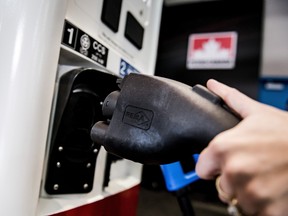Fake prices in the involuntary auto economy

Article content
In the magic world of the electric vehicle, nothing is priced at cost plus profit. Since there are no honest profits yet to be made in the Canadian EV market, the business of developing, producing, marketing and selling electric vehicles operates under a centrally planned command-and-control economic system. Nothing is real in the EV market, from the price of new Chevy Bolts to the cost of manufacture to the cost of filling up an EV at a charging station.
Advertisement 2
Article content
As Investopedia wisely instructs, in a market economy consumer preferences and resource scarcity determine which goods are produced and in what quantity. “The prices in a market economy act as signals to producers and consumers who use these price signals to help make decisions. Governments play a minor role in the direction of economic activity.” In a centrally planned command economy, decision-making is centralized. “The government controls all of the supply and sets all of the demand. Prices cannot arise naturally like in a market economy, so prices in the economy must be set by government officials.”
That pretty much defines the EV market today and as it will exist in the future under government mandates that will force the auto industry to stop selling internal combustion engine (ICE) vehicles by 2035. Consumers will have no choice in the matter. As Environment Minister Steven Guilbeault said the other day, “it will not be voluntary.” Governments plan to control prices, investment and consumer decisions, regardless of the reality of costs.
Advertisement 3
Article content
Costs, in fact, are to be buried, obscured and lied about. Take, for example, the current claims by EV proponents that charging an EV is real cheap, maybe $6 or $10, compared with $100 to fill up with gasoline. The $10 charge is a fake, however, while the $100 gas price is real. The price of gasoline includes the price of crude oil, royalties paid to governments and the refinery cost. But gas prices also include the cost of operating a gasoline station and the taxes imposed by governments to pay for the road networks and other infrastructure. The only cost recorded in the frequently cited $10 EV price is the cost of the electricity.
Recharging an EV involves costs that are not included in the $10. At a typical Petro-Canada EV charge station in Ontario, a fast-charge that takes 45 minutes is priced on the basis of time spent waiting for the charge at 33 cents per minute or $14.85. Sounds cheap. Petro-Canada collects a portion of the charge as its revenue, the rest goes to electricity. But the charge-station price does not take in the full cost. Under Ottawa’s Zero Emission Vehicle Infrastructure Program, Petro-Canada’s Electric Highway project would have received millions in subsidies. The program offered incentives of up to $75,000 for each individual fast charger to cover 50 per cent of charger project costs up to $5 million.
Advertisement 4
Article content
In all, Ottawa is reportedly planning to spend $880 million over the next four years to build 65,000 charger stations at an average cost of $14,000. EV drivers are not paying that cost. Some estimate as many as four million charge stations will be needed. At current rates, that works out to $56 billion in subsidies above the price of electricity.
Governments also charge taxes on gasoline, revenue that is at least nominally collected to pay for roads and other infrastructure needed to support transport. Road spending will still be needed with EVs on the road. At current gas prices of $1.45 a litre, Ontario drivers currently pay 25 cents a litre in federal/provincial taxes (excluding carbon and sales taxes), which means that an EV driver should also be paying the equivalent amount to cover the same road cost. The tax-cost of filling up a gas engine at current prices, about $20, should be added to the price of an EV charge.
Advertisement 5
Article content
In future, the electricity grid and power supply will also have to be upgraded with uncountable billions in new spending needed to finance vast new speculative electricity production systems. These costs will have to be passed on to EV chargers or subsidized.
-

Terence Corcoran: Any conflicts? Nah. We’re all in this together
-

Terence Corcoran: Carbon race to the bottom for subsidies
-

Terence Corcoran: The imploding new world economic order
Today’s $10 EV charge claim is obviously a fiction that buries the real cost through government spending and subsidies. What’s the real cost? My starting guesstimate is around $50 per charge. What would that do to popular conception about the competitiveness of electric vehicles, especially if consumers also had to give up other subsidies?
Advertisement 6
Article content
The fake EV cost numbers don’t stop there. There is constant pressure to increase the EV buyer “incentives,” which now range between $5,000 and $13,000 per vehicle depending on the province, to $15,000 nationally. Ottawa is expected to announce an incentive policy in the next budget.
Behind the retail façade is an even greater cost-fixing process under constant expansion. Every day brings new subsidies. In Ontario, where Premier Doug Ford has installed himself as CEO of the auto industry, Honda announced a $1.3-billion plant conversion to build hybrid EVs, with $260 billion in federal and provincial subsidies. Germany’s BASF and General Motors each announced new electric battery component plants to be built in Bécancour, Que., with a combined value of close to $1 billion. Subsidy deals were not disclosed.
There’s more to be expected in coming months, years and decades.
What role will consumers, prices and markets play in the new EV industry? None. The EV industry is under the command and control of government central planners. Forgive the cliché, but: “What could go wrong?”
• Email: [email protected] | Twitter: terencecorcoran
